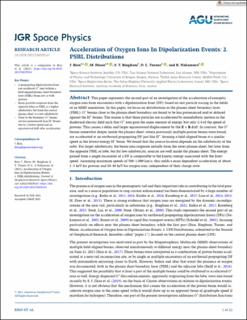| dc.description.abstract | This paper represents the second part of an investigation of the acceleration of energetic oxygen ions from encounters with a dipolarization front (DF), based on test particle tracing in the fields of an MHD simulation. In this paper, we focus on distributions in the plasma sheet boundary layer (PSBL). O+ beams close to the plasma sheet boundary are found to be less pronounced and/or delayed against the H+ beams. The reason is that these particles are accelerated by nonadiabatic motion in the duskward electric field such that O+ ions gain the same amount of energy, but only 1/4 of the speed of protons. This causes a delay and larger equatorward displacement by the E × B drift. In contrast, the O+ beams somewhat deeper inside the plasma sheet, where previously multiple proton beams were found, are accelerated at an earthward propagating DF just like H+, forming a field-aligned beam at a similar speed as the lowest-energy H+ beam. We found that the source location depends on the adiabaticity of the orbit. For larger adiabaticity, the beam ions originate initially from the outer plasma sheet, but later from the opposite PSBL or lobe, but for low adiabaticity, sources are well inside the plasma sheet. The energy gained from a single encounter of a DF is comparable to the kinetic energy associated with the front speed. Assuming maximum speeds of 500–1,000 km/s, this yields a mass dependent acceleration of about 1–5 keV for protons and 20–80 keV for oxygen ions, independent of their charge state. | en_US |
